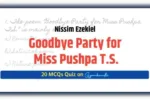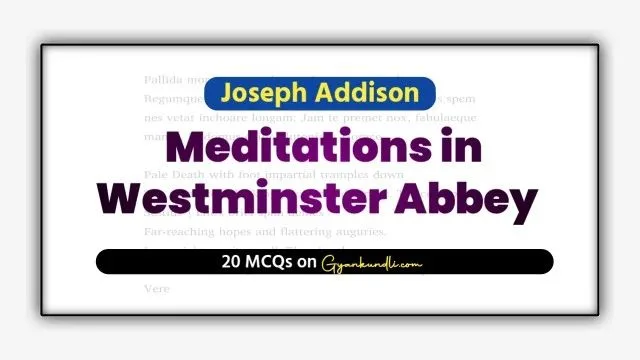Sailing to Byzantium is a well-known poem by W.B. Yeats, first published in his collection October Blast in 1927 and re-published in his collection The Tower in 1928. The poem was written when Yeats was growing old, and it reflects his thoughts on aging, the decay of the body, and the search for immortality of the soul.
In this poem, Yeats contrasts the lively world of youth, full of passion and sensual pleasures, with the world of old age, which must turn towards the spirit. The poet chooses Byzantium, the ancient holy city famous for its art and golden mosaics, as a symbol of eternal wisdom and permanence. By sailing to Byzantium, Yeats imagines himself leaving behind the temporary world of desires and reaching a place where the soul can achieve immortality through art and spiritual realisation.
About the Poet William Butler Yeats (1865–1939)
William Butler Yeats was one of the greatest poets of the 20th century and a leading figure of the Irish Literary Revival. He combined Irish mythology, folklore, mysticism, and modern symbolism in his poetry. In 1923, he was awarded the Nobel Prize in Literature for his inspired poetry, which gave expression to the spirit of a whole nation.
Yeats’s poetry shows two main phases:
1. Early poetry – Romantic, dreamy, influenced by Irish legends and mysticism.
2. Later poetry – Philosophical, symbolic, often focused on old age, immortality, and spiritual truth.
Yeats and Sailing to Byzantium
The poem Sailing to Byzantium (1928) belongs to Yeats’s later period. Written when he was about sixty-two, it reflects his personal concern with old age and the need for the soul to rise above sensual life. Byzantium is used as a symbol of spiritual permanence and eternal art, contrasting with the decay of the physical body. The poem shows Yeats’s deep interest in the Upanishads and Yoga philosophy, making it spiritually rich and universal in appeal.
In this poem, Yeats expresses his belief that while youth is bound to passion and mortality, old age must turn towards the soul and seek immortality through art and self-realisation. Thus, the poem is not just personal but a universal meditation on the eternal journey of the soul.
Famous Writings of W.B. Yeats
Poetry Collections:
- The Tower (1928) – includes Sailing to Byzantium, Leda and the Swan.
- The Winding Stair and Other Poems (1933) – includes Byzantium.
- The Wild Swans at Coole (1919).
- Responsibilities (1914).
- The Rose (1893).
Famous Poems:
- The Second Coming
- The Lake Isle of Innisfree
- Easter 1916
- Among School Children
- When You Are Old
Plays and Prose:
- Cathleen ni Houlihan (play, 1902).
- A Vision (1925, revised 1937) – his philosophical work.
About the Poem Sailing to Byzantium
Sailing to Byzantium is one of the most famous poems of W.B. Yeats, published in his collection The Tower (1928). Yeats wrote it when he was growing old, and the poem reflects his deep concern with age, mortality, and the search for spiritual permanence.
In this poem, the poet contrasts the world of the young and sensual with the world of the old and spiritual. Youth is shown as a time of passion, love, and physical pleasures. Young men and women are absorbed in each other, birds sing in trees, and fishes fill the rivers and seas during their season of reproduction. All mortal creatures live under the law of birth, desire, and death. In such a world, the soul and higher truth are often forgotten.
For the poet, old age is different. He feels that an old man without spiritual awakening is as useless as a “tattered coat upon a stick.” When the body grows weak, it is the soul that must be nourished. The soul has to rise above worldly desires and seek eternal wisdom.
Byzantium, the holy city of art and spirituality, becomes the symbol of eternal life in the poem. Yeats imagines himself sailing across the seas of worldly attachments to reach Byzantium. Once there, he wishes to leave behind the decay of the body and become like a work of art, shining with permanence. In the final vision, he imagines himself as a golden bird set upon a golden tree, singing of timeless truths and spiritual knowledge, not of sensual pleasures.
Thus, the poem is not only about Yeats’s personal old age but also about the universal human desire to move beyond death and attain immortality.
Text of Sailing to Byzantium
I
That is no country for old men. The young
In one another’s arms, birds in the trees,
—Those dying generations—at their song,
The salmon-falls, the mackerel-crowded seas,
Fish, flesh, or fowl, commend all summer long
Whatever is begotten, born, and dies.
Caught in that sensual music all neglect
Monuments of unageing intellect.
II
An aged man is but a paltry thing,
A tattered coat upon a stick, unless
Soul clap its hands and sing, and louder sing
For every tatter in its mortal dress,
Nor is there singing school but studying
Monuments of its own magnificence;
And therefore I have sailed the seas and come
To the holy city of Byzantium.
III
O sages standing in God’s holy fire
As in the gold mosaic of a wall,
Come from the holy fire, perne in a gyre,
And be the singing-masters of my soul.
Consume my heart away; sick with desire
And fastened to a dying animal
It knows not what it is; and gather me
Into the artifice of eternity.
IV
Once out of nature I shall never take
My bodily form from any natural thing,
But such a form as Grecian goldsmiths make
Of hammered gold and gold enamelling
To keep a drowsy Emperor awake;
Or set upon a golden bough to sing
To lords and ladies of Byzantium
Of what is past, or passing, or to come.
Form, Meter and Rhyme Scheme of Sailing to Byzantium
The poem Sailing to Byzantium is written in four stanzas, each containing eight lines (ottava rima form). In total, the poem has 32 lines.
The meter of the poem is iambic pentameter. Each line usually has ten syllables, arranged in five iambic feet (an unstressed syllable followed by a stressed syllable). Sometimes Yeats adds an extra syllable for smoothness of sound.
The rhyme scheme of each stanza is ABABABCC. The first six lines alternate in rhyme, while the stanza ends with a rhymed couplet that gives closure and emphasis to the thought.
This structure creates a steady rhythm and lyrical flow, while the final couplet in each stanza delivers a strong concluding note.
Summary of Sailing to Byzantium by W.B. Yeats
The poem describes life as a journey of the soul through three stages—childhood, youth, and old age. The poet, now old, looks back and realises that youth belongs only to the young. Youth is a time of physical passion and procreation.
Young men and women are absorbed in each other, birds sing in trees during the mating season, and fishes like salmon and mackerel follow their natural instinct to reproduce. Thus, the world of youth is dominated by sensual pleasure, music of the senses, and the cycle of birth and death. In such a life, the eternal soul is forgotten.
Yeats says that the life of an old man is useless if he does not awaken his soul. He compares such a man to a “tattered coat upon a stick,” unless he learns to nourish his spirit and rise above worldly desires. The poet feels that he has crossed the sea of worldly attachments and is now sailing towards Byzantium, which symbolises the holy city of the soul, a place of spiritual wisdom and eternal art.
The poet prays that his senses should return to his soul, just as a hawk comes back to its master. He wants his desires to be burnt away so that his soul may become free from the sickness of passions and realise its divine nature. He longs for liberation from the decay of the human body and wishes to attain a state of permanence, like a work of art created by the skilled goldsmiths of Byzantium.
Finally, Yeats imagines himself as a golden bird set upon a golden tree, singing not of sensual pleasures but of eternal truths, history, and spirituality. This image represents the soul’s immortality and freedom from the limitations of time, age, and decay.
Critical Analysis of Sailing to Byzantium
W.B. Yeats’s poem Sailing to Byzantium is one of his most celebrated and widely discussed works. It was published in The Tower (1928) and composed in 1927, when the poet was about sixty-two years old. At this stage of life, Yeats was turning away from worldly attachments and was deeply influenced by the Upanishads and Patanjali’s Yoga Sutra. The poem reflects his philosophical search for the eternal soul beyond the decay of the physical body.
Symbolism and Philosophy
The central symbol of the poem is Byzantium, an ancient holy city of the Eastern Roman Empire, famous for its golden art, mosaics, and religious grandeur. Yeats uses it as a metaphor for the “city of the soul” or the realm of spiritual wisdom. The poem expresses the poet’s journey away from sensual desires toward eternal truth.
According to the Upanishadic thought, man consists of three parts—the gross body, the subtle body, and the Atman. The gross body is mortal and perishable, while the subtle body is immortal and contains the Atman, or the Self. Yeats symbolically calls this subtle golden body the “city of Byzantium.” His voyage towards Byzantium is therefore a voyage toward self-realisation and liberation of the soul.
Contrast Between Youth and Old Age
The poem begins with a sharp contrast between the world of youth and the world of old age.
Youth is dominated by sensual pleasures, passion, procreation, and the charm of bodily music. Young men and women are lost in love, birds sing and mate, and fish swarm the seas to reproduce. In this world, there is no thought of the soul or eternity.
Old age, however, is useless if it remains bound to sensual life. An old man without spiritual awakening is compared to “a tattered coat upon a stick.” Yeats emphasises that old age must strive to nourish the soul, turn inward, and rise above desires to achieve higher wisdom.
Spiritual Journey
The poet sees himself as sailing away from the sea of worldly passions towards Byzantium, the spiritual city. He prays for his senses and desires to be consumed so that his soul may be purified. He seeks to enter a state of Samadhi, where the soul realises its eternal and divine nature. Once free from the prison of the body and mind, the soul becomes immortal, like a work of art that never decays.
In the final stanza, Yeats imagines himself as a golden bird on a golden tree, not singing of sensual love but of eternal truths. This symbol represents the poet’s desire for permanence and his escape from the cycle of birth and death.
Imagery and Style
The poem is rich in symbolic and striking imagery:
“Fish, flesh, or fowl” = the sensual world of youth.
“A tattered coat upon a stick” = futility of old age without the soul’s awakening.
“Monuments of unageing intellect” = works of eternal art and wisdom.
“Golden bird upon a golden tree” = immortality of the soul.
The poem consists of 32 lines in four stanzas, each stanza having eight lines. The metre is iambic pentameter, and each stanza ends with a rhymed couplet. The rhythm is musical and lyrical, full of alliteration, rhyme, and half-rhyme. The diction is simple yet elevated, and the style blends Romantic imagination with Symbolist technique.
Sailing to Byzantium is not only a personal poem about Yeats’s old age but also a universal meditation on the contrast between the mortal body and the immortal soul. Its symbolism is deeply rooted in Indian philosophy, especially the Upanishads and Yoga. For this reason, Indian critics have been able to unlock its meaning with clarity. The poem stands as one of Yeats’s greatest achievements, where poetry, philosophy, and symbolism combine to create a masterpiece of spiritual vision.
Discover more from Gyankundli
Subscribe to get the latest posts sent to your email.











